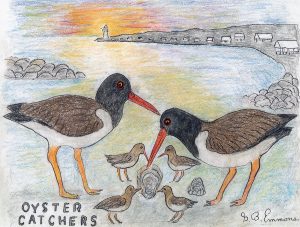My usual afternoon ceremonial is along the shore of Crescent Beach, about half way to Ned’s Point Lighthouse where, what to my wondering eyes should appear, recently were two Oystercatchers never before encountered after years of bird watching.
They were feeding on the mud flats of the inlet of the marsh near Pico Beach, a more startling and striking appearance than most shore birds with long, bright red bills, red-rimmed eyes, black heads, dark brown backs, and white belly and base of tail, with white wing stripe on inner flight feathers.
True to their name, they are able to catch and devour oysters. They do this by stabbing and hammering the shell with repeated blows until opening a hole to cut through the adductor muscle and then inserting the bill in the opening and forcing the shell apart. These techniques are learned as the young emulate their parents, depicted in my illustration viewable online.
Their unlined nests with usually four buff-colored eggs are hidden in a shallow depression on a little mound of sand above the high tide mark.
After hatching, the chicks are precocial (relatively mature at birth), fully feathered, but dependent on the parents for about two months until bills are long and strong enough to open shells.
Even though they may appear tame at times, the Audubon Society cautions against approaching too close, as with a camera, because ground-nesting species are flighty if they feel their young and nests have been discovered. For example, their inland cousin, the killdeer plover, will feign the broken wing trick to divert attention elsewhere, and a woodcock hen will actually pick up each egg or newborn chick and gently, one by one, fly low over the ground to a more secret location.
Most people see shorebirds in mid to late summer when they are on vacation or near the coast as they migrate south from Artic breeding grounds. In the fall, they see young in juvenile color, as well as adults in transition between summer and winter plumage. Shorebird numbers have increased in recent years through conservation efforts for clean shellfish waters, and long before that, a ban on shooting.
The ritual of this afternoon walk for bird watching ends with sunset, but another subject of wildlife observation to share with you is just a day away.
By George B. Emmons
